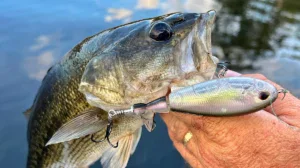In this video, professional angler Bryant Smith breaks down what makes a vibrating jig more effective in today’s heavily pressured fisheries. While nearly every angler throws one, making small adjustments can lead to big results. Smith reveals his go-to bait and explains why its sound and tighter vibration outshine traditional jigs.
Featured Products
- VIBRATING JIG: Strike King Tungsten Thunder Cricket: Buy at Bass Pro Shops | Buy at Tackle Warehouse
- TRAILER: Strike King KVD Perfect Plastics Blade Minnow: Buy at Bass Pro Shops | Buy at Tackle Warehouse
- ROD: Alpha Angler Chatterbound 7’2″ Casting Rod: Buy at Alpha Angler
- REEL: Lew’s Custom Pro SLP 7.5:1 Casting Reel: Buy at Bass Pro Shops
- LINE: Strike King Contra Fluorocarbon, 17-pound: Buy at Tackle Warehouse
The Efficiency of a Vibrating Jig
Smith reaches for a vibrating jig whenever the water’s full of grass and bass are spread out. It allows anglers to fish fast, cover a lot of water, and still maintain the subtle vibration and profile that get bites. No matter the time of year, the goal is to find active fish. A vibrating jig cuts through vegetation, stays clean, and keeps moving — all while producing the kind of movement that draws fish in from a distance.
Why Tungsten Changes the Game
Tungsten delivers a louder and sharper vibration that draws fish from farther away. Unlike a lead jighead, tungsten doesn’t muffle the blade’s movement. These particular attributes can give anglers just enough of an edge to trigger more strikes — especially in heavily vegetated water where fish may be more cautious.
Adjusting Cadence and Retrieve
Smith focuses on how changing retrieve speed and rhythm can trigger more bites throughout the day. Whether it’s a steady pull, a quick lift and drop, or brief pauses to let the bait flutter down — adjusting cadence helps keep the presentation natural. Those subtle changes don’t just keep fish engaged — they make your bait stand out. Small adjustments to retrieve speed can create a reaction bite, especially when fish are tracking the bait from a distance.










